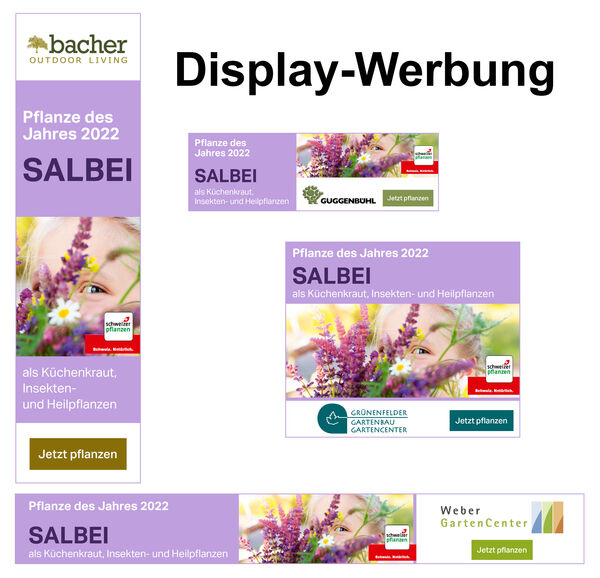When surfing the web, the user repeatedly sees display advertising.
It is, so to speak, the picture advertisement of the internet. Since a picture is worth a thousand words, this is where the great potential of this advertising opportunity lies.
With an appealing picture language, you attract the user's attention. Supplemented with a short, snappy message, there is a good chance that you will be able to direct the user to your website or a landing page. landing page. Once the interest is aroused, the potential customer will naturally customer naturally wants to find out more. When he the target platform, the so-called landing page of the advertiser, the desired information on the target platform, the advertiser's or thinks he is in a different place, the user is the user is gone as quickly as he arrived. he came. So the landing page must be similar design to the banner or vice versa - or vice versa - and of course contain information that encourages the potential customer to take further action. This can be ordering a product, visiting the shop or signing up for a newsletter.
More reach for less money
Display marketing is particularly well suited for image advertising, pushing an article/assortment or publicising an event. Especially for image advertising and the promotion of events, the frequent insertion of advertising can have a positive effect. Currently, display advertising used correctly offers a great advantage over a classic advertisement. For the same amount of money, you get a massively higher reach and, as a rule, you can advertise in a much more targeted way. Once a campaign has been prepared, it can be started or stopped at the touch of a button. This offers the advantage of being able to react to current circumstances, such as the weather. In addition, the reach of a successful campaign can be campaign can be increased immediately in order to more users.
Select format and billing system There are different types of display advertising. One is static banners, which have a fixed size and design.
The difficulty is that there are countless advertising formats, analogous to different ad sizes, and a separate banner must be designed for each format. On the other hand, there are so-called responsive banners. Here, various images and texts are prepared from which the (Google) system then automatically compiles the banners. banners automatically. Afterwards, a software software evaluates which combination is most successful combination is most successful, and then of these versions. To be successful with this system system, meaningful pictures and and texts are central.
Video ads are also becoming increasingly popular. Here, a short video is played. They are also very interesting from a marketing point of view, but due to the high costs, they are more suitable for large marketing for large marketing budgets.
There are two different billing systems for display campaigns: either you pay per click or per impression. "Per impression" means that an amount is due per insertion. In most cases, prices are defined per 1000 impressions. In the vast majority of cases, the "payment per click" model is more advantageous, as it usually generates a large number of impressions that bring additional advertising benefits. However, you only pay if someone clicks on the advertisement. At first glance, payment per impression also seems attractive. However, experience shows that the impressions are used up very quickly without many users having clicked on the banner.
In addition, with the model per click, you can monitor much better whether these clicks have really led to the target page.
In general, with digital advertising it is more difficult to estimate what value you will get for your budget, as this depends on many factors and basically follows the pricing of supply and demand. In the case of the advertisement, you probably know the circulation and can thus estimate how high the reach of the advertisement is. However, it is not known how many people have actually seen your ad and taken action. Digital advertising measures have the advantage that they can be precisely measured, quantified and, above all, optimized in a very timely manner. However, it takes some experience to interpret and classify the results correctly in order to take the right actions.

Knowing how
As with text ads, the largest provider of display advertising is Google. The advantage of Google is that the ads can be controlled very specifically. For example scattering areas on the basis of individual selected on the basis of individual demographic characteristics such as age, gender, income age, gender, income class and interests can be defined. Only if a user meets the desired criteria, he or she will be shown the ad.
Google has a network of millions of websites where you can place the ads. The text and display ads can be created relatively easily. However, the options and settings have been expanded so much in the last few years that a layman can quickly lose track and probably not get the best cost/benefit ratio out of his ads.
There are numerous websites that manage their banner ads themselves and have corresponding offers. Depending on the target group of the website, it can make sense to advertise in this environment. As a rule, one delivers a fixed banner here, which is then displayed within a defined framework and budget.
Experience shows that display marketing is especially successful when it is used and optimized over a longer period of time. Then the initialization costs costs are usually in a reasonable to the pure advertising costs.
In all marketing campaigns, it is the the mix of all measures is what makes the success. From our point of view banners belong in every portfolio of digital digital advertising portfolio.


